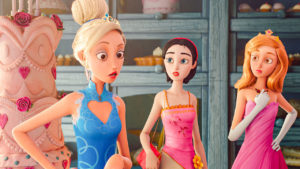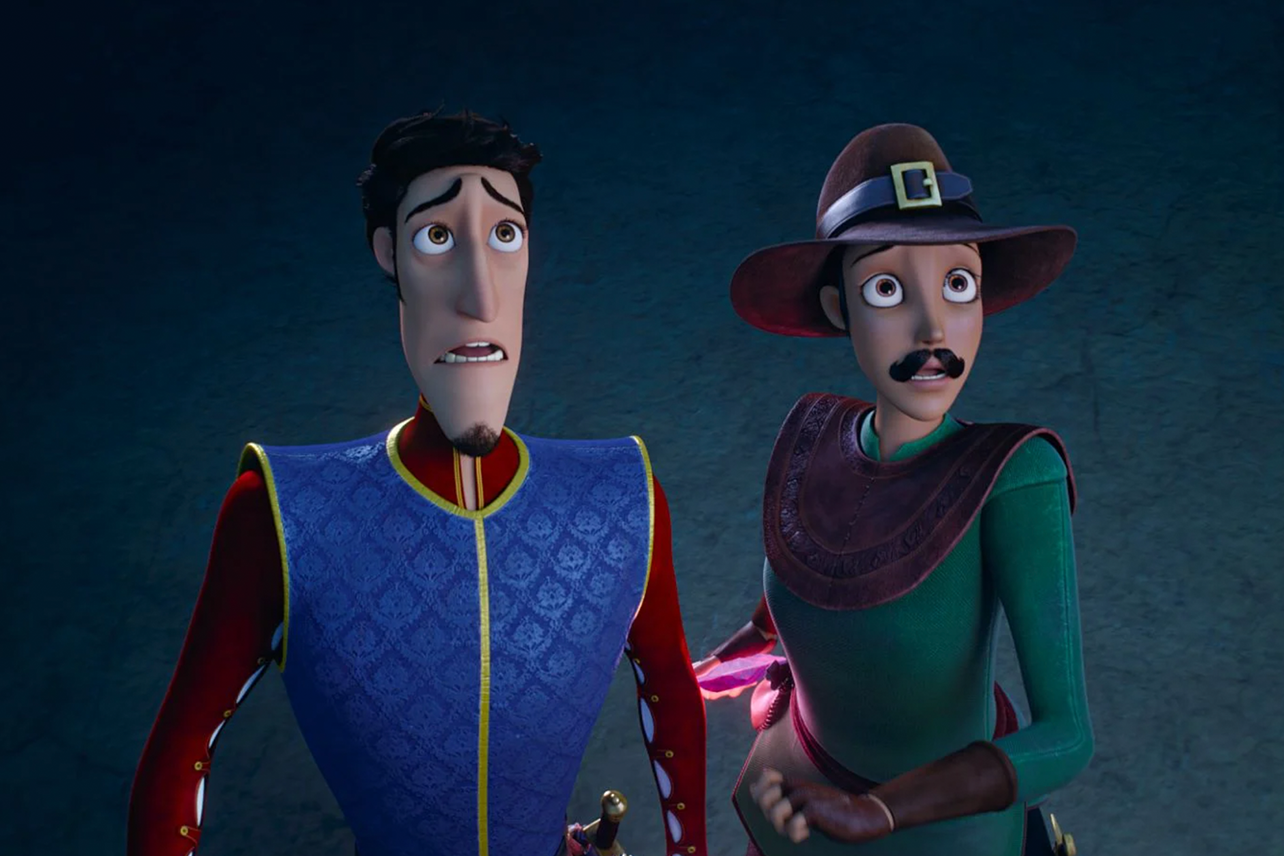“Prince” Charming: Distinct literary character, composite amalgam, or generic studmiffuin? Here’s a film that claims to have the answer. Does it have the real answer? No, of course not. Technically, Prince Charming is from Cinderella (Disney’s Cinderella, to be sure), but the modern fairy tale world has connected “Charming” with Cinderella, Snow White, and Sleeping Beauty (and Rapunzel for that matter) making each tale all the sadder. All damsels want is a generic, unstudied version of manhood? Of course they do.
Delightful as it may seem to see three classic characters all affianced to the same fleeting jerk, Charming is playing in shark-infested waters: there’s not just the claim here that all Disney maidens are saved by a man; this film essentially claims all three Disney heroines are –essentially- the same shallow, trophy-hunting, cheerleader-pyramid-topping girl with different hair color. How is that gonna go over with your Cinderella/Snow White/Sleeping Beauty loving child? No matter. The opening number just goes on and on describing how charming Charming is; he’s pretty much wooed every female in the fiefdom – and, strangely, no males- all of whom are ready and willing to drop their habit for some Charming charming.
Why is this happening? A curse. Of course. Always a curse … even in non-Disney, it’s always a curse. Does Charming (voice of Wilmer Vilderarrama) love anybody? No. He’s just Charming. Well this, too, is worth investigating: if Charming weren’t charming, whom would he woo and why?
Enter Lenore (Demi Lovato), a professional thief. Charming falls for her instantly almost entirely because Lenore –in unique fashion- reciprocates no affection whatsoever. If you think there’s something wrong with that, you’re not alone. And it’s not that this isn’t a comment on human nature; those with many choices always seem to want the thing they can’t have … but is that the lesson you ought to be pushing? “Successful men, I know you have several choices of mate out there, but no matter how much they unnecessarily attend to you, screw ‘em; go for the one you have to convince.” Does that sound even a little right to you?
The next section of film works much better than the end pieces: tired of his sons’ lack of direction, King Charming sends the prince on a dangerous quest to end the curse and –perhaps- find himself. Of course, the prince has always been Charming, hence has developed not a single workable talent for such a quest. Hence the King also authorizes a guide, which comes in the form of Lenore in disguise as “Lenny” (and/or “Squiggy”).
Odd, isn’t it? Here’s a film with a feminist take – a useless protagonist guided through perils by a highly skilled woman in disguise … and yet, the film still has several named female characters who show no distinctive personality attributes and only talk about their upcoming weddings. ALSO we know that Lenore is destined for Charming because, of course, no woman –no matter how skilled or accomplished- is complete without a man.
protagonist guided through perils by a highly skilled woman in disguise … and yet, the film still has several named female characters who show no distinctive personality attributes and only talk about their upcoming weddings. ALSO we know that Lenore is destined for Charming because, of course, no woman –no matter how skilled or accomplished- is complete without a man.
And again I ask – is this really the message you want to send to the li’l Disney princess in your house?
The bookends of this film are problematic. I neither enjoyed the start nor the finish. But I did enjoy the questing, and I warmed to Charming and Lenore once they warmed to one-another. Is that good enough to babysit your child instead of Frozen 2? Probably not, but maybe after you tire seeing Olaf’s face on the screen seven days in a row you’ll go for something else.
There once was a Charming attractor
Who collected each fem when he lacked her
It’s a dangerous plan
He’s in trouble now, man
Cuz the end game was never a factor
Rated TV-Y7, 85 Minutes
Director: Ross Venokur
Writer: Ross Venokur
Genre: Exploiting Disney
Type of being most likely to enjoy this film: Parents who resent Disney formula
Type of being least likely to enjoy this film: Disney princesses



